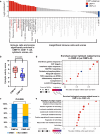Immune microenvironmental heterogeneity according to tumor DNA methylation phenotypes in microsatellite instability-high colorectal cancers
- PMID: 39235590
- PMCID: PMC11377388
- DOI: 10.1007/s00262-024-03805-3
Immune microenvironmental heterogeneity according to tumor DNA methylation phenotypes in microsatellite instability-high colorectal cancers
Abstract
The detailed association between tumor DNA methylation, including CpG island methylation, and tumor immunity is poorly understood. CpG island methylator phenotype (CIMP) is observed typically in sporadic colorectal cancers (CRCs) with microsatellite instability-high (MSI-H). Here, we investigated the differential features of the tumor immune microenvironment according to CIMP status in MSI-H CRCs. CIMP-high (CIMP-H) or CIMP-low/negative (CIMP-L/0) status was determined using MethyLight assay in 133 MSI-H CRCs. All MSI-H CRCs were subjected to digital pathology-based quantification of CD3 + /CD8 + /CD4 + /FoxP3 + /CD68 + /CD204 + /CD177 + tumor-infiltrating immune cells using whole-slide immunohistochemistry. Programmed death-ligand 1 (PD-L1) immunohistochemistry was evaluated using the tumor proportion score (TPS) and combined positive score (CPS). Representative cases were analyzed using whole-exome and RNA-sequencing. In 133 MSI-H CRCs, significantly higher densities of CD8 + tumor-infiltrating lymphocytes (TILs) were observed in CIMP-H tumors compared with CIMP-L/0 tumors. PD-L1 TPS and CPS in CIMP-H tumors were higher than in CIMP-L/0 tumors. Next-generation sequencing revealed that, compared with CIMP-L/0 tumors, CIMP-H tumors had higher fractions of CD8 + T cells/cytotoxic lymphocytes, higher cytolytic activity scores, and activated immune-mediated cell killing pathways. In contrast to CIMP-L/0 tumors, most CIMP-H tumors were identified as consensus molecular subtype 1, an immunogenic transcriptomic subtype of CRC. However, there were no differences in tumor mutational burden (TMB) between CIMP-H and CIMP-L/0 tumors in MSI-H CRCs. In conclusion, CIMP-H is associated with abundant cytotoxic CD8 + TILs and PD-L1 overexpression independent of TMB in MSI-H CRCs, suggesting that CIMP-H tumors represent a typical immune-hot subtype and are optimal candidates for immunotherapy in MSI-H tumors.
Keywords: Colorectal carcinoma; CpG Island methylation; DNA methylation; Microsatellite instability; Mismatch repair; Tumor immunology.
© 2024. The Author(s).
Conflict of interest statement
The authors have no relevant financial or non-financial interests to disclose.
Figures




Similar articles
-
Clinical significance of programmed cell death-ligand 1 expression and the immune microenvironment at the invasive front of colorectal cancers with high microsatellite instability.Int J Cancer. 2018 Feb 15;142(4):822-832. doi: 10.1002/ijc.31107. Epub 2017 Oct 31. Int J Cancer. 2018. PMID: 29044503
-
Differential clinicopathological features in microsatellite instability-positive colorectal cancers depending on CIMP status.Virchows Arch. 2011 Jul;459(1):55-63. doi: 10.1007/s00428-011-1080-3. Epub 2011 Apr 15. Virchows Arch. 2011. PMID: 21494758
-
Characterisation of PD-L1-positive subsets of microsatellite-unstable colorectal cancers.Br J Cancer. 2016 Aug 9;115(4):490-6. doi: 10.1038/bjc.2016.211. Epub 2016 Jul 12. Br J Cancer. 2016. PMID: 27404452 Free PMC article.
-
Molecular and prognostic heterogeneity of microsatellite-unstable colorectal cancer.World J Gastroenterol. 2014 Apr 21;20(15):4230-43. doi: 10.3748/wjg.v20.i15.4230. World J Gastroenterol. 2014. PMID: 24764661 Free PMC article. Review.
-
Four molecular subtypes of colorectal cancer and their precursor lesions.Arch Pathol Lab Med. 2011 Jun;135(6):698-703. doi: 10.5858/2010-0523-RA.1. Arch Pathol Lab Med. 2011. PMID: 21631262 Review.
Cited by
-
Evaluation of Pan-Cancer Immune Heterogeneity Based on DNA Methylation.Genes (Basel). 2025 Jan 26;16(2):160. doi: 10.3390/genes16020160. Genes (Basel). 2025. PMID: 40004489 Free PMC article.
References
-
- Suzuki MM, Bird A (2008) DNA methylation landscapes: provocative insights from epigenomics. Nat Rev Genet 9:465–476. 10.1038/nrg2341 - PubMed
-
- Esteller M (2002) CpG island hypermethylation and tumor suppressor genes: a booming present, a brighter future. Oncogene 21:5427–5440. 10.1038/sj.onc.1205600 - PubMed
-
- Hughes LA, Melotte V, de Schrijver J, de Maat M, Smit VT, Bovee JV et al (2013) The CpG island methylator phenotype: what’s in a name? Cancer Res 73:5858–5868. 10.1158/0008-5472.CAN-12-4306 - PubMed
MeSH terms
Substances
Grants and funding
LinkOut - more resources
Full Text Sources
Medical
Research Materials

